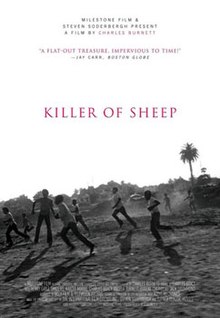Killer of Sheep
| Killer of Sheep | |
|---|---|

2007 re-release theatrical poster
|
|
| Directed by | Charles Burnett |
| Produced by | Charles Burnett |
| Written by | Charles Burnett |
| Starring |
Henry G. Sanders Kaycee Moore Charles Bracy Angela Burnett |
| Cinematography | Charles Burnett |
| Edited by | Charles Burnett |
| Distributed by | Milestone Films |
|
Running time
|
80 minutes |
| Country | United States |
| Language | English |
| Budget | $10,000 |
| Box office | $416,509 |
Killer of Sheep is a 1978 American drama film written, directed, produced, and shot by Charles Burnett. It features Henry G. Sanders, Kaycee Moore, and Charles Bracy, among others. The drama depicts the culture of urban African-Americans in Los Angeles' Watts district. The film's style is often likened to Italian neorealism.
At the time of completion, the film could not be released because the filmmakers had not secured rights to the music used in the film. The rights were purchased in 2007 at a cost of US $150,000 and the film was restored and transferred from a 16mm to a 35mm print. Killer of Sheep received a limited release 30 years after it was completed, with a DVD release in late 2007.
Film critic Dana Stevens describes the film's plot as "a collection of brief vignettes which are so loosely connected that it feels at times like you're watching a non-narrative film." There are no acts, plot arcs or character development, as conventionally defined.
Stan works long hours at a slaughterhouse in Watts, Los Angeles. The monotonous slaughter affects his home life with his unnamed wife and two children, Stan Jr. and Angela.
Through a series of confusing episodic events – some friends try to involve Stan in a criminal plot, a white woman propositions Stan to work in her store, Stan and his friend Bracy attempt to buy a car engine – a mosaic of an austere working-class life emerges in which Stan feels unable to affect the course of his life.
Directed by Charles Burnett, Killer of Sheep was shot in Watts on a budget of less than US$10,000 (equals $38,087.76 in 2016 dollars) over roughly a year's worth of weekends in 1972 and 1973, with additional shooting in 1975. In 1977, Burnett submitted the film as his Master of Fine Arts thesis at the School of Film at the University of California, Los Angeles. Burnett stated that he also intended to make the film a history of African-American music and filled it with music from a variety of genres and different eras.
...
Wikipedia
